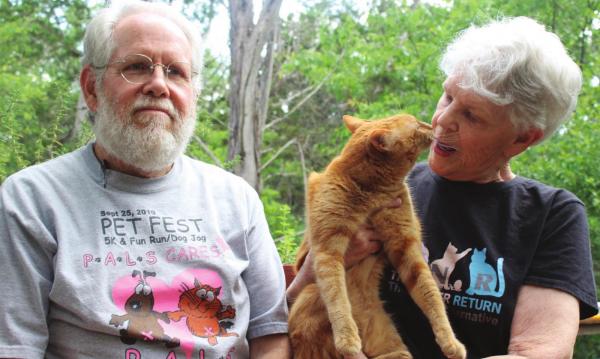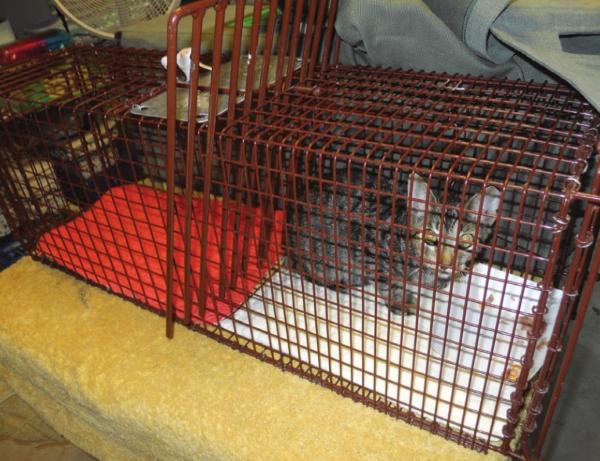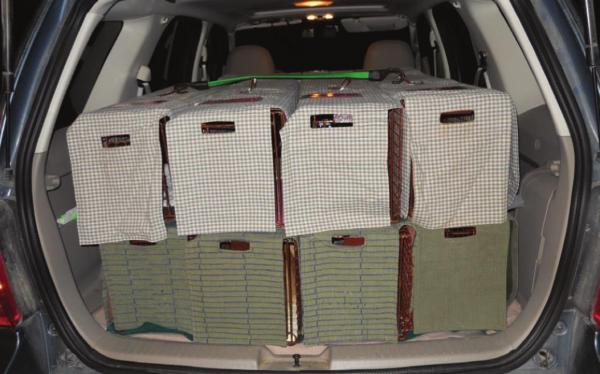Helping keep the cats in check
Cats can start reproducing when they are five months old. They can typically have two to three litters a year. That can add up to 15 or so kittens annually.
According to the Humane Society, a pair of breeding cats can exponentially give birth to 420,000 cats over seven years.
That’s a cat for every resident of Lubbock and Waco with enough left over to cover Sequin.
Dale Nave and Marcia Sanderson are working to put a dent in that figure. Dale and Marcia run the PAWS Wimberley TNR Program.
The T stands for trapping. The N is for neutering. The R is for return.
“We don’t win this game,” says Marcia, “but it’s what we love to do. Most people will say: ‘We started out with two cats — now we need your help.’”
The process goes like this:
Marcia or Dale get a call from a business or a homeowner who has a problem with wild cats. Dale and Marcia set out traps. Once captured, the cats are taken to a veterinarian — typically the Humane Society in Austin — where they are spayed or neutered, get a rabies shot and are treated for fleas, worms and ear mites. The cats are then returned back to the area where they were caught. A small notch is cut into the cat’s ear to identify it as having been treated.
The cycle of reproduction has been broken.
“The research shows that this is most humane way to deal with this problem,” says Marcia. “We don’t call these feral cats. We call them community cats, because they are part of our community.”
“These animals can live for the rest of their lives,” Dale adds, “and they won’t be reproducing.”
No-kill zone
Dale and Marcia won’t euthanize a cat. “If you want to kill them, call someone else,” says Marcia.
Marcia estimates there are thousands of feral cats in Hays County. Dale, who has been capturing and treating cats since 2008, stopped counting after he caught 1,000 cats. Marcia has trapped 1,200 cats in the 10 years she has been doing it.
What’s the difference between a stray cat and a feral cat? According to the Humane Society, a stray is a cat that has been lost or abandoned. It has had human contact and is used to people. A feral cat is wild, territorial and tries to avoid people.
There are a number of problems associated with feral cats that are not spayed or neutered:
— The population just keeps growing;
— There are loud noises from fights over territory and mating;
— Strong odors from male cats marking their territory;
— Flea infestations;
— Spreading diseases to the domesticated cat population;
— And, the suffering of vulnerable kittens and adult cats that have been injured.
Some kittens can be adopted out and become a house cat, but once a feral cat is seven weeks old it has pretty much become a wild cat for life.
Typically, feral cats live in “colonies.” The colonies often form around food sources — someone who feeds them or around a supermarket or restaurant trash container. The cats are shy and fear humans so most people don’t even realize there’s a colony nearby. Once the cat population starts to explode, malnutrition and disease can set in.
The biggest colony Marcia has tackled was 37 cats. She managed to trap 36 of the cats and they were desexed and treated. One female calico escaped capture and may well still be roaming out there, doing what cats do. “Males will come from miles around,” says Marcia.
Marcia says she has personally responded to at least 15 calls from businesses in and around the Wimberley Square. The cats that roam the Wimberley Market Days property keep the rodent population there in check, have been fixed and are “some of the best fed cats around,” says Dale.
Marcia and Dale have also trapped cats around the post office and near the bird refuge near the Community Center and Brookshire Brothers market. The bird refuge was a special challenge because of the potential food source from the nearby supermarket. Says Dale: “If it’s a well-fed cat it generally won’t go after birds.”
They’re scared
Usually, once they are captured the cats are relatively docile. They are scared and huddle in the corner of the state-of-theart traps Dale and Marcia use. The more they meow, the friendlier they are, says Marcia. The traps are covered during transport so the cat has a dark, secure atmosphere. Marcia has only been bitten once — recently by a kitten — and scratched a couple times. “A feral cat can be very difficult to handle,” says Marcia.
It’s heartbreaking, says Marcia, when they trap a female cat that is lactating. That means there’s a litter of kittens out there somewhere. Coyotes are a natural predator of feral cats, but the helpless kittens often fall prey to raccoons and other animals. The biggest threats to the wild cats are disease and malnutrition.
The cost to spay or neuter and treat a cat runs from $20-$48 dollars. That’s a bargain price for a procedure that can sometimes run a hundred dollars or more. Marcia and Dale make frequent two-hour round trip runs to the Humane Society in Austin, but sometimes they are booked. Local vets, clinics and shelters help out. The cats generally stay at the clinic for six hours or so and then are held for a day so they can recover before they are released.
The cost adds up — buying the traps, feeding the cats and transporting them. The trapping and return project gets grants from the Wimberley Community Civic Club and the Lion’s Club as well as from individual donors. Home or business owners who request help are also asked to help defray the cost. “I always say if you cannot afford it we have community funds,” says Marcia.
As with most labors of love, Dale and Marcia often dip into their own pocketbooks. “Sometimes we make the decision to provide medical care that exceeds what we believe should be charged to the program and we will pick up the extra. It’s hard not to get attached to the cats that we help,” explains Marcia.
Dale, who has four cats at his Rainbow Ranch home, was a middle and high school teacher locally for 30 years. Marcia, who lives in Woodcreek , also has four cats and is retired from the University of Texas School of Social Work.
They are always looking for volunteers, people who can help trap the cats, feed them or provide a temporary foster home. If you want to help or make a donation you can email [email protected]. edu.
Marcia gets many word-of-mouth referrals as well as from the PAWS program in Dripping Springs and the Wimberley Adoption Group and Rescue (WAG).
“It’s so hard to make a dent out there,” says Marcia. “But you know with the one cat you have helped, you have made a difference.”




